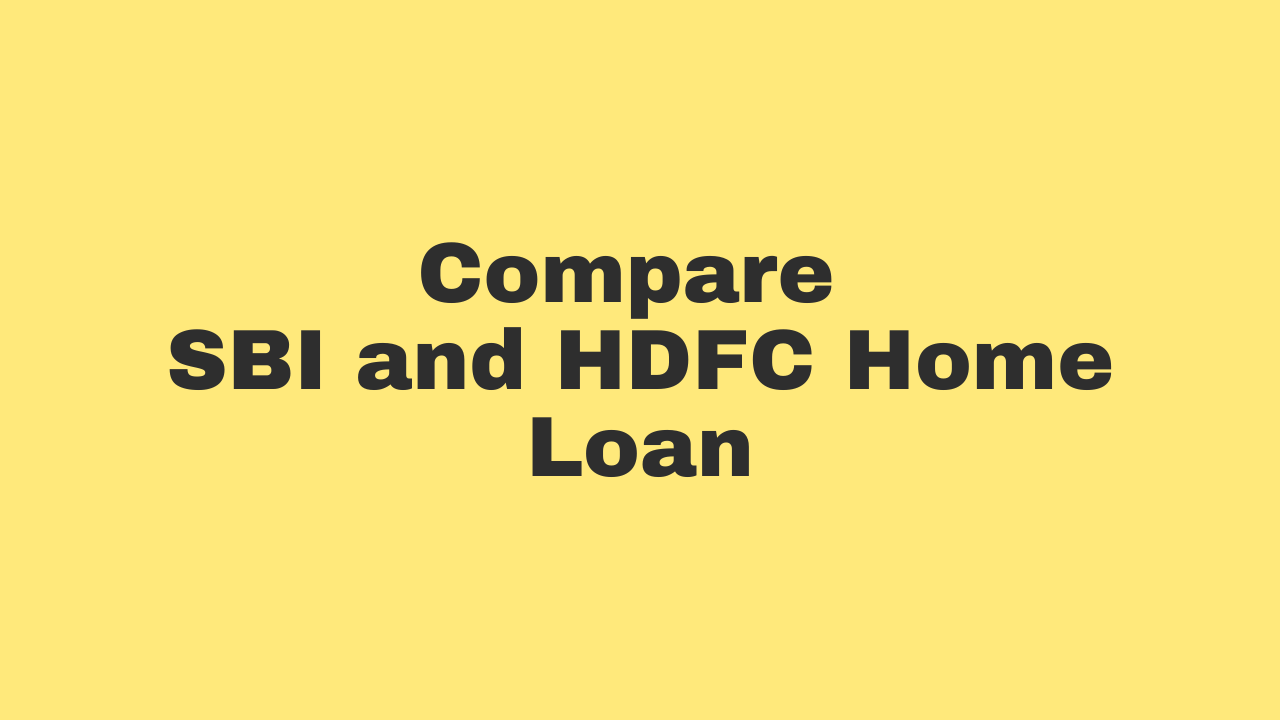When planning to buy a home in India, a home loan is often the ideal choice to finance your purchase. Among the top choices are SBI (State Bank of India) and HDFC (Housing Development Finance Corporation), two leading banks known for their attractive home loan offerings, customer service, and accessibility.
Both banks provide competitive interest rates, flexible repayment options, and unique features. However, choosing between them depends on various factors, such as interest rates, eligibility criteria, processing fees, and repayment options.
This article offers an in-depth comparison of SBI and HDFC home loans to help you make an informed decision.
SBI Home Loans
The State Bank of India (SBI) is India’s largest bank, offering a range of home loan products catering to various customer needs. Some popular SBI home loan schemes include the SBI Regular Home Loan, SBI Flexipay Home Loan, SBI MaxGain Home Loan, and SBI Realty Home Loan. Key features of SBI home loans include:
- Competitive interest rates, especially for salaried applicants
- Flexible loan tenure, ranging up to 30 years
- Special interest rate concessions for women borrowers
- Reduced processing fees and special offers for SBI account holders
SBI also offers home loans under the Pradhan Mantri Awas Yojana (PMAY) scheme, which provides interest subsidies for eligible customers.
HDFC Home Loans
HDFC, a pioneer in the home finance industry, offers an extensive range of home loan options. HDFC home loans cater to salaried and self-employed individuals with diverse requirements. The HDFC home loan portfolio includes the HDFC Home Loan for Salaried, HDFC Home Loan for Self-employed, HDFC Reach Home Loan, and HDFC TruFixed Home Loan. Key features of HDFC home loans include:
- Flexible loan tenure up to 30 years
- Fixed and floating interest rate options
- Doorstep loan servicing for certain locations
- Home improvement loans and top-up loans
- Personalized home loan advisory services
Comparison Factors
To evaluate SBI and HDFC home loans, we’ll compare several important factors such as interest rates, loan tenure, processing fees, eligibility criteria, and additional benefits.
Interest Rates
- SBI Home Loan Interest Rates: SBI offers floating interest rates starting from 8.40% per annum for salaried individuals. Women borrowers typically enjoy a 0.05% concession on the standard rate. SBI’s home loan interest rates vary based on the applicant’s credit score and loan amount.
- HDFC Home Loan Interest Rates: HDFC also provides competitive interest rates, starting from 8.45% per annum for salaried individuals. Similar to SBI, HDFC provides a concession for women borrowers and determines rates based on the borrower’s credit profile.
Winner: SBI generally has slightly lower interest rates for salaried borrowers compared to HDFC.
Loan Tenure
Both SBI and HDFC offer loan tenures of up to 30 years, which helps reduce EMI (Equated Monthly Installment) amounts, making them affordable for long-term borrowers.
Winner: Tie – Both banks offer a maximum tenure of 30 years.
Processing Fees
- SBI Processing Fees: SBI charges processing fees between 0.35% and 0.50% of the loan amount, with a maximum cap of INR 10,000 plus applicable taxes. SBI frequently offers discounts or waivers on processing fees for special occasions and to loyal customers.
- HDFC Processing Fees: HDFC’s processing fee ranges from 0.50% to 1.0% of the loan amount or INR 3,000 to INR 10,000, whichever is higher. HDFC also runs offers to waive processing fees for limited periods.
Winner: SBI generally has lower processing fees compared to HDFC.
Eligibility Criteria
Both SBI and HDFC have flexible eligibility criteria for home loan applicants, which mainly include:
- SBI Home Loan Eligibility: Minimum age 18 years, maximum age 70 years at loan maturity, stable income, and a good credit score (generally above 650). Both salaried and self-employed individuals are eligible.
- HDFC Home Loan Eligibility: Minimum age 21 years, maximum age 65 years at loan maturity. HDFC looks for a stable income, a good credit score, and a minimum employment tenure. Eligibility varies slightly for salaried and self-employed applicants.
Winner: SBI has a slightly lower minimum age requirement.
Loan Amount and LTV (Loan to Value) Ratio
- SBI Loan Amount: SBI offers loans up to 90% of the property value, depending on the loan amount. For loans above INR 75 lakh, SBI provides 75% to 80% financing.
- HDFC Loan Amount: HDFC also offers up to 90% financing for home loans under INR 30 lakh and 80% for loans above INR 30 lakh. For high-value properties, HDFC’s financing is generally capped at 75%.
Winner: Tie – Both banks have similar LTV ratios and loan amounts.
Prepayment and Foreclosure Charges
- SBI Prepayment Charges: SBI does not levy any prepayment or foreclosure charges on floating-rate home loans, encouraging borrowers to pay off loans early if possible.
- HDFC Prepayment Charges: HDFC does not charge prepayment fees on floating-rate home loans. However, a small fee may apply to fixed-rate loans if prepayment exceeds a certain limit.
Winner: SBI has a slight edge as all floating-rate prepayments are free.
Special Schemes and Offers
- SBI Special Schemes: SBI offers several special schemes like the SBI Flexipay, which allows salaried borrowers to pay only interest during the moratorium period and lower EMIs initially, and SBI MaxGain, a unique overdraft facility linked to a home loan. SBI also provides loans under PMAY.
- HDFC Special Schemes: HDFC offers TruFixed Home Loan, which allows borrowers to lock in a fixed interest rate for a set period before moving to a floating rate. HDFC also participates in the PMAY scheme and provides home improvement loans.
Winner: Tie – Both banks have unique schemes catering to different borrower needs.
Comparison Table
Feature | SBI Home Loans | HDFC Home Loans |
|---|---|---|
Interest Rate | Starting from 8.40% (floating) | Starting from 8.45% (floating) |
Loan Tenure | Up to 30 years | Up to 30 years |
Processing Fees | 0.35% – 0.50% (max INR 10,000) | 0.50% – 1.0% (min INR 3,000 – max INR 10,000) |
Minimum Age Requirement | 18 years | 21 years |
Loan Amount (LTV Ratio) | Up to 90% (varies with loan amount) | Up to 90% (varies with loan amount) |
Prepayment Charges | Nil for floating-rate loans | Nil for floating-rate loans; applicable on fixed-rate |
Special Schemes | Flexipay, MaxGain, PMAY, Realty Home Loan | TruFixed Home Loan, Reach Loan, PMAY |
Interest Concessions | Yes (for women borrowers) | Yes (for women borrowers) |
Pros and Cons
SBI Home Loan
Pros:
- Competitive interest rates, especially for salaried applicants
- Concession in interest rates for women
- No prepayment charges on floating-rate loans
- Multiple home loan schemes to choose from
Cons:
- Processing times may be longer than private banks
- Limited flexibility in interest rates compared to HDFC
HDFC Home Loan
Pros:
- Flexible tenure and competitive interest rates
- Fixed-rate options for part of the loan tenure
- Doorstep service and faster processing times
- Extensive loan schemes and advisory services
Cons:
- Higher processing fees
- Fixed-rate loan prepayment fees can be restrictive
Which Home Loan is Right for You?
Choosing between SBI and HDFC home loans ultimately depends on your preferences and financial goals. If you’re looking for lower interest rates and minimal prepayment charges, SBI may be the better choice. SBI’s range of home loan schemes, including Flexipay and MaxGain, can be attractive for borrowers seeking flexible EMI options.
On the other hand, HDFC offers slightly more personalized services with a range of home loan products and better processing efficiency, which can benefit those who prefer quick approvals and flexible fixed-rate options for part of the tenure.
For long-term affordability and if you’re eligible under PMAY, both banks can be great options. However, it’s advisable to compare current offers from each bank, consider pre-approval, and choose a loan that best aligns with your requirements.

Ranjan is a dedicated finance writer for smartfinclub.com, where he specializes in comparing top financial products in India, including loans, credit cards, savings accounts & more. With a focus on providing clear insights into features, rates, and benefits, Ranjan aims to empower readers to make informed financial decisions customized to their needs.

